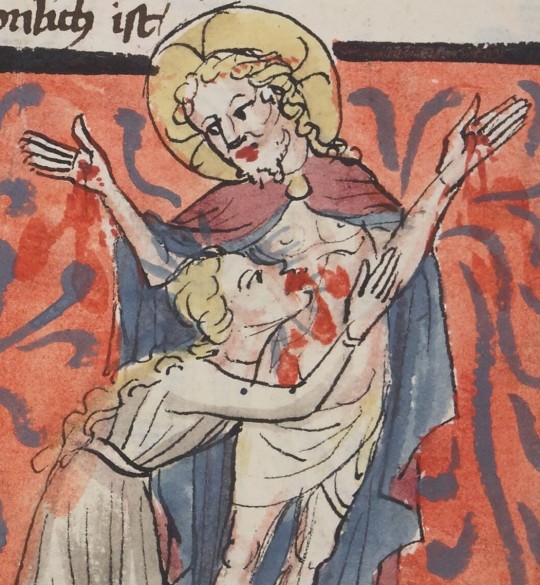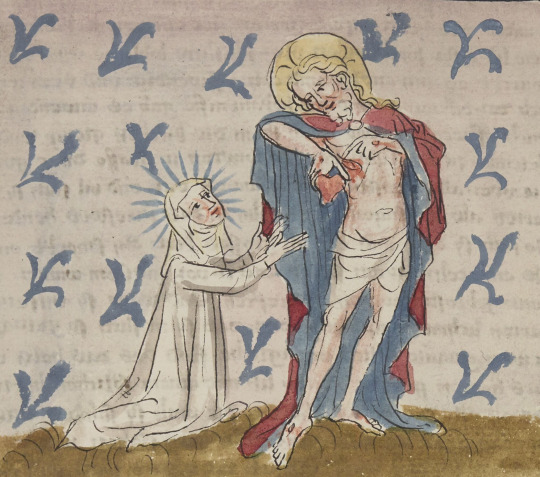Text
God is holding me in his arms trying to get me to settle down a little and i am clawing and hissing and biting so much
10K notes
·
View notes
Text
“I am God, who enables the humble-minded to understand more of the ways of everlasting truth in a single moment than in ten years’ study at university. I teach in silence, without the uproar of controversy, without ambition for honours, without clash of opinions. I teach people to despise earthly things, to find this present life irksome, to seek eternal things, to resist honours, to endure injuries, to place all trust in Me, to desire nothing but Myself and fervently to love Me above all things.”
—
From The Imitation of Christ, by Thomas a Kempis

Sculpture: Christ as the Man of Sorrows, attributed to Heinrich Iselin (c. 1480).
23 notes
·
View notes
Photo

Fra Angelico, The Dormition and Assumption of the Virgin (detail), 1424-1434. Tempera with oil glazes and gold on panel, 61.8 x 38.3 cm. Isabella Stewart Gardner Museum, Boston.
1K notes
·
View notes
Photo

Anne Carson, Glass, Irony and God
299 notes
·
View notes
Text
“No one will hurt or destroy on all my holy mountain. For the earth will be full of the knowledge of the Lord as the waters cover the sea.”
— Isaiah 11:9
12 notes
·
View notes
Text

A Lebanese Orthodox nun lighting a candle in the shrine of Sayyidat al-Nouriyyeh (Our Lady of Light) in Beirut. The shrine was later looted and completely destroyed during the Lebanese Civil War.
2K notes
·
View notes
Text

'The Woman with the Candle' (detail) by Cornelis Visscher II, c. 1643 - 1658
2K notes
·
View notes
Photo

‘Drink, daughter, from my side’
Catherine of Siena’s biography records a vision in which she drinks from the open wound on the side of Jesus:
“With that, he tenderly placed his right hand on her neck, and drew her towards the wound in his side. ‘Drink, daughter, from my side,’ he said, ‘and by that draught your soul shall become enraptured with such delight that your very body, which for my sake you have denied, shall be inundated with its overflowing goodness.’ Drawn close in this way, … she fastened her lips upon that sacred wound, … and there she slaked her thirst.”
The painting was made by Flemish artist Louis Cousin, a.k.a. Luigi Primo or Luigi Gentile (c. 1605–1667).
6 notes
·
View notes
Text


st. catherine of siena drinking from christ's side wound
in a hagiography of st. catherine of siena, alsace, early 15th c.
source: Paris, BnF, ms. allem. 34, fol. 43v
5K notes
·
View notes
Text
“In the end, it is faith and love, not thought, which attracts us to this strange figure on the cross.”
— Kenneth Leech, We Preach Christ Crucified
(via godinourhands)
116 notes
·
View notes
Text

Ade Bethune, "St. Catherine of Siena visiting the prisoner", courtesy of the Ade Bethune Collection at St. Catherine University
177 notes
·
View notes
Note
How does one go about praying?
by breathing or speaking or being silent or thinking or not thinking, by loving or suffering or feeling pain or feeling joy or not feeling much at all, by touching someone or giving five dollars to a guy flying a sign or feeding someone or braking so you don't hit a squirrel with your car. prayer is just a way of being in relationship with the world, with the other.
638 notes
·
View notes
Photo

Was it good for you, too?
Francesco Vanni’s painting of Catherine of Siena, made around 1590, is a good example of Christian mystical encounters portrayed in extremely physical ways.
“Especially women, but men too, described ecstatic experiences in which they nursed from Christ’s side wound as if it was a breast, or felt themselves penetrated by Christ, or so lost themselves in mystical adoration and abandonment that they experienced physical shuddering that seem most akin to orgasm,” art historian Martha Easton writes.
“The question is, how are we to interpret such experiences? Some would suggest that these are the Freudian yearnings of those who have often suppressed more typical human sexual experiences because of religious beliefs and practices. Others would argue that it is incorrect to assume that modern and medieval understandings of sexuality necessarily coincide; that in fact we must allow for an alterity to medieval people that allows phenomena of a deeply physical nature to be seen as spiritual. And still others would argue that it is possible that these types of experiences can be both religious and sexual, even erotic.”
Was It Good For You, Too? Medieval Erotic Art and Its Audiences by Martha Easton, 2008, Different Visions: A Journal of New Perspectives on Medieval Art
33 notes
·
View notes
Text


christ taking his heart out of his side wound to hand it to st. catherine of siena
in a hagiography of st. catherine of siena, alsace, early 15th c.
source: Paris, BnF, ms. allem. 34, fol. 54r
1K notes
·
View notes


